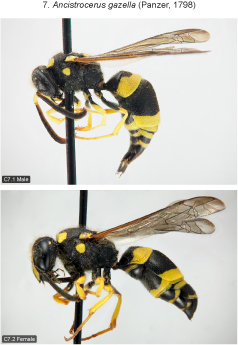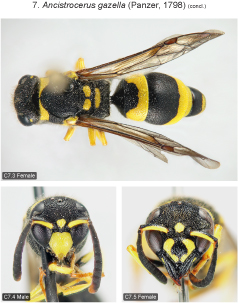
| Home | Table of contents | Keys | Species list | Glossary | Image data | PDF | Cite this article | Feedback | Updates |
Identification Atlas of the Vespidae (Hymenoptera, Aculeata) of the northeastern Nearctic region
CJAI 05, February 19, 2008
doi: 10.3752/cjai.2008.05
Matthias Buck, Stephen A. Marshall, and David K.B. Cheung
Department of Environmental Biology, University of Guelph, Guelph, Ontario, Canada N1G 2W1
Next species | Previous species | Key
7. Ancistrocerus gazella (Panzer, 1798)
Figs B1.15; B2.17; B3.6, 9, 40; C7.1–5.

|

|
Species recognition. This species is very similar to A. parietum, with which it shares the extensive yellow markings and somewhat concave sternum 2. Besides characters given in the key A. gazella differs from A. parietum by the somewhat shorter hairs of the head and mesosoma, the more produced humeral angle, and the minutely roughened and therefore slightly duller longitudinal ridges of the female clypeus (completely polished and glossy in A. parietum).
Variation. Fore wing length 6–7 mm (♂♂), 6.5–8 mm (♀♀). Humeral angle of pronotum more or less produced; in female usually, in male always produced at least slightly beyond level of anterior margin of pronotum, and in female usually, in male always at least slightly curved outward. Female clypeus usually yellow with a central black spot extending to dorsal margin of clypeus and sometimes ventral margin as well; rarely reduced to just a more or less parallel-sided streak; in dark specimens clypeus black with a pair of large yellow dorsal spots and a smaller pair of ventral spots; ventral spots sometimes absent. Yellow spot along inner orbit elongate or reduced to small spot in male, in female a small spot usually present. Yellow pronotal band occupying approximately anterior 1/3–1/2 of pronotum. Parategula black, often marked with yellow. Pair of yellow scutellar spots usually better developed in female than in male; in female the spots usually very narrowly separated, rarely confluent or more broadly separated from each other. Metanotal band usually very broad in female; narrower in male, sometimes interrupted medially or absent. Metasomal terga 1–5 fasciate, the fascia of tergum 5 usually abbreviated laterally, rarely absent; tergum 6 rarely with a small yellow preapical spot (probably more often present in male). Usually sterna 1–4 or 1–5 fasciate; fascia of sternum 1 sometimes obscure medially; fasciae on sterna 2–5 emarginate or interrupted laterally; fascia of sternum 2 (and 3 in male) always complete, fascia of sternum 3 in female (4 in male) rarely interrupted laterally; fascia of sternum 4 in female (5 in male), if present, usually interrupted laterally; sternum 5 of female, 6 of male sometimes with a small posteromedial yellow spot.
Distribution. Canada: Ontario. Eastern U.S.: MA, NY, NJ, DE (Buck et al. 2006), newly recorded from MI (photographic record, Bugguide), RI (photographic record, Bugguide), and MD (photographic record, Bugguide). Native to the Palaearctic: Europe to Afghanistan; Northwest Africa, Canary Islands and Madeira; introduced in New Zealand (Dvořák and Castro 2007). Ancistrocerus gazella was introduced to the U.S. before 1961 when the first specimen was collected in New York. In Ontario the species was collected for the first time in 1983. Due to confusion with another introduced species, A. parietum, the species was not noticed by Nearctic workers before 2005 (Buck et al. 2006).
Biology. The biology of this species is similar to that of A. parietum in that it nests in a great variety of natural and man-made cavities such as hollow stems, borings in wood, and holes in brick-and-mortar walls or metal rails (Blüthgen 1961).
Next species | Previous species | Key
| Home | Table of contents | Keys | Species list | Glossary | Image data | PDF | Cite this article | Feedback | Updates |
